iPhone 11 Pro Review
It's all about the camera
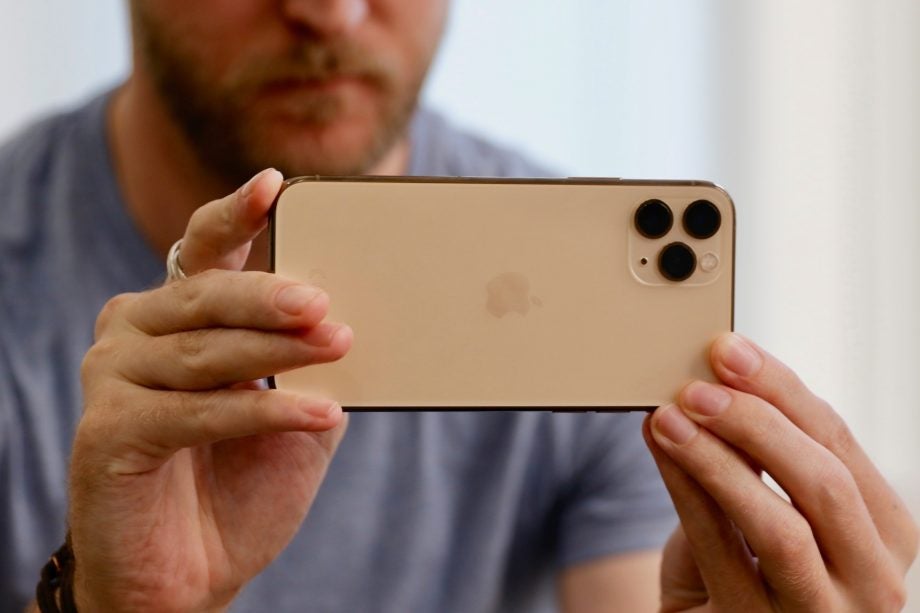
Sections
- Page 1 iPhone 11 Pro Review
- Page 2 iPhone 11 Pro Camera Review
- Page 3 iPhone 11 Pro Battery Life Review
- Page 4 iPhone 11 Pro Performance Review
Verdict
While the iPhone 11 Pro looks nearly identical to its predecessor, the changes Apple has made do make it a much better phone. The three cameras on the back are truly excellent and might just be my favourite trio of sensors on any phone. The video recording, audio and super-bright XDR display are all tremendous too. This is also the first 5.8-inch iPhone that doesn’t feel hamstrung by a battery that needs constant attention to get it through a full day. All that being said, there are still areas I would have liked to see Apple push forward in, especially as it has now decided to call these phones ‘Pro’. 5G was never going to happen, but would have been nice anyway; some sort of TouchID-enabled fingerprint sensor inside the display and the rumoured reverse wireless charging that could have juiced up a pair of AirPods would all have been welcome features.
Pros
- A lovely bright display
- Camera system is excellent
- Strong battery life
Cons
- Design hasn’t changed much and the notch remains annoying
- 64GB still the base storage option
Key Specifications
- 5.8-inch Super Retina XDR display with HDR
- A13 Bionic chipset
- Reported 4GB RAM
- Storage options ranging from 64GB to 512GB
- 18w charger in the box
- 3x 12-megapixel cameras
Who is the iPhone 11 Pro for?
If you want the fully-loaded 2019 flagship iPhone 11 then the iPhone 11 Pro is the one for you. While I wouldn’t necessarily say this is the best iPhone for everyone, it’s a fantastic buy that stands as one of the most complete iPhones Apple has ever made.
After using the iPhone 11 Pro on a daily basis since its release, my original opinion hasn’t changed and in many ways I like the phone even more. iOS 13 has picked up lots of updates to squash that huge amount of bugs that were there at release and the excellent battery life has become even more obvious. You don’t need to buy the larger phone to achieve a comfortable all-day battery life.
But it’s still the triple camera array on the back that makes this such a great phone and this has become even more obvious after the launch of the Pixel 4. While Google’s new flagship takes excellent snaps, the versatility afforded by the three iPhone sensors just gives you so much more freedom. The video recording remains the best on the market too and the facial unlocking is, again, far superior to anything else you can currently get.
For a far more in-depth look at the iPhone 11 Pro then continue reading.
- Prefer something cheaper? Our iPhone 11 review is for you
Camera
- Is this the iPhone camera to topple the competition?
The iPhone 11 Pro packs three distinct 12-megapixel cameras, which for the first time in an Apple device, includes an ultra-wide angle lens (13mm equivalent, f/2.4). You also get a standard lens (26mm, f/1.8) and a 2x telephoto lens (52mm, with an improved maximum aperture of f/2.0).
Related: Best iPhone Deals
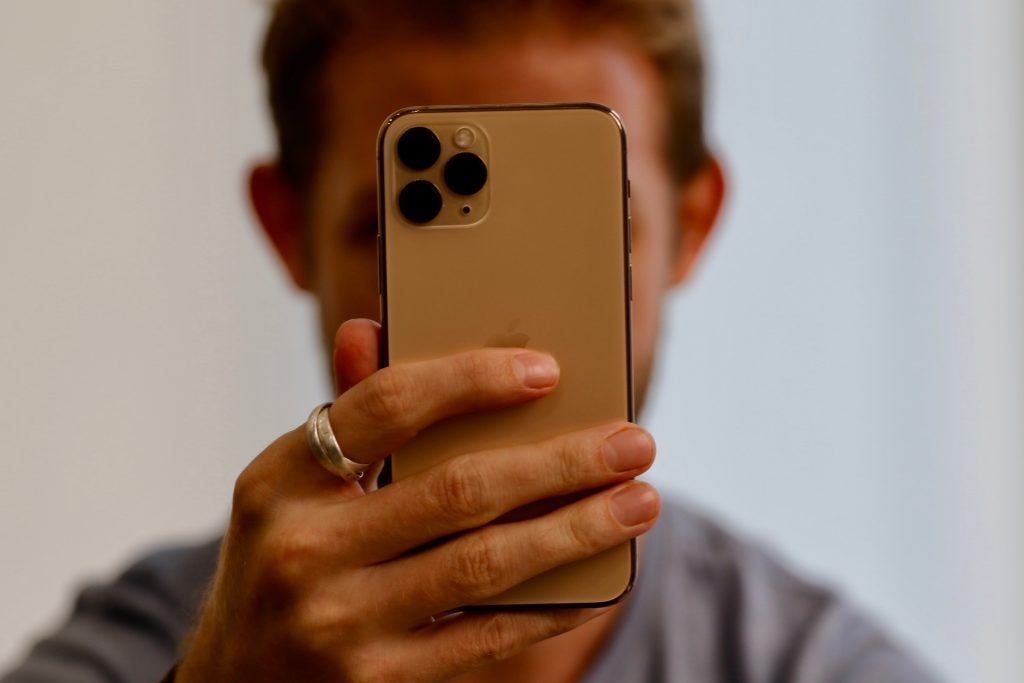
- These are the best camera phones
Apple has seriously improved its photographic output with the iPhone 11 Pro (and with the iPhone 11 in many ways) and it now stands toe-to-toe with the best out there. I would even go as far as saying it’s my favourite smartphone camera thanks to the quality of all three cameras, the reliable – if not manually accessible – Night Mode and the sheer sharpness of daylight photos.
Even though the megapixel count hasn’t changed in years, the 11 Pro takes supremely detailed snaps with lovely colour reproduction across all three cameras. You zoom in and zoom out without noticing you’re changing lenses – something that normally trips up other triple-camera phones.
Night Mode is a feature we’ve been wanting on iPhone for a number of years now, and finally we have it. The iPhone 11 Pro’s take on this mode is a little different, as it comes on automatically when the light is low and can’t be manually flipped on and off. This can be slightly annoying, as in a few instances I would have preferred to be able to turn it on myself.
The mode works by shooting a number of short exposures then combining them together to produce a finished image which gives the impression of a long exposure. The iPhone 11 Pro will decide for itself how many seconds to shoot for, but you can use a slider to take control of it, while attaching the phone to a tripod will see the mode jump to the maximum number of seconds.

Ultra Wide (left) vs Wide (right)
It’s hard to give a definitive verdict on which phone out of the iPhone 11 Pro, Google Pixel 3 and Huawei P30 Pro take the best night shots, as they can vary a lot depending on conditions. The iPhone images have a tendency to sometimes look a little over-sharpened if you zoom in, but the bright and vivid colours make up for this.
Video recording is excellent too, easily the best on any phone you can buy now. We’ve got a load more video samples and thoughts on our iPhone 11 Pro camera page so head there for all the details about this fantastic camera.
- For a far more in-depth look at the camera read our iPhone 11 Pro camera review
Performance and iOS 13
- The fastest small phone around
The iPhone 11 Pro is an absolute performance beast, with the new A13 Bionic chipset helping put it up there with the fastest phones we have reviewed. That should come as no surprise to anyone who is familiar with Apple’s silicone, as it has constantly been ahead of the competition from Qualcomm, Samsung and Huawei.
Paired with the A13 is a completely new U1 chip. This is able to directly communicate with other iPhones packing the U1 to transfer files through AirDrop, without the need for a connection. There’s also, according to the Geekbench benchmarking app, 4GB inside. Apple never details its RAM specs and the amount has rarely affected how well an iPhone performs.
Simply claiming the iPhone 11 Pro feels ‘fast’ feels like its underplaying this chip. Yes, scrolling around is fast and smooth while apps open instantaneously. You can play all the new games in Apple’s £4.99 Arcade subscription service without ever so much as a dropped frame or judder. But, then again, that’s very much the case with iPhones going back a few years. If you’re moving from an iPhone X, an iPhone XS or even an iPhone 8 I doubt you’ll notice an immediate speed difference.
Related: Apple Arcade games
But this chipset isn’t just about pure speed. The A13 Bionic enables a load of the tricks that really set the 11 Pro apart: 4K 60fps video recording from all the cameras, for instance, and the much improved Smart HDR that churns out such exceptional pictures. The A13 accounts for the snappier FaceID sensor that unlocks the phone too, and you can definitely see the phone recognising your face quicker than before.
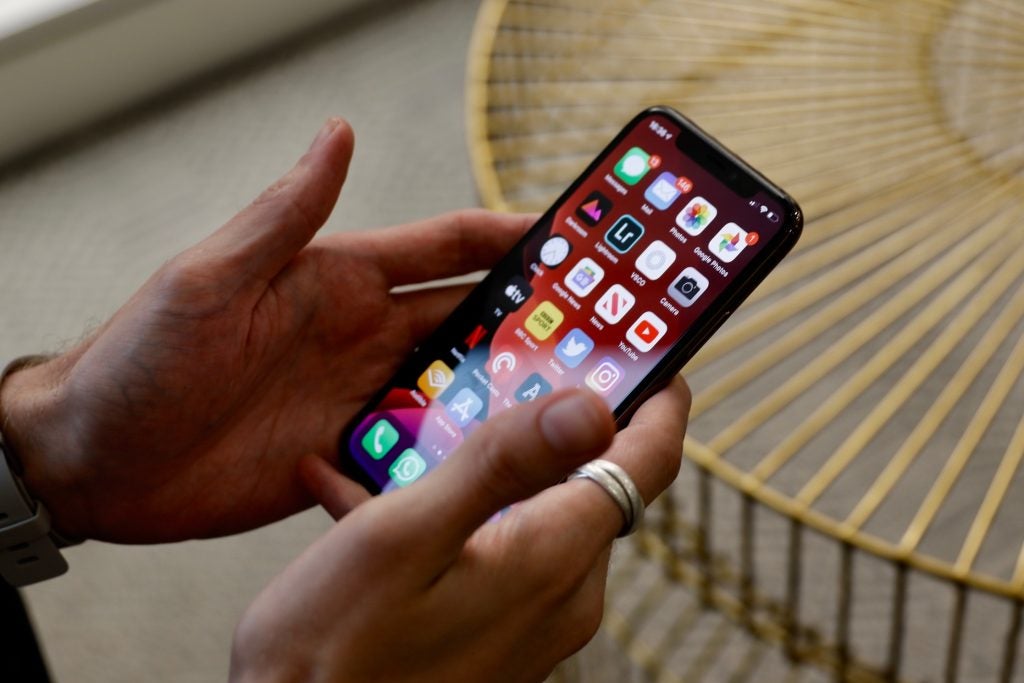
FaceID still sits inside the notch
I’m happy with Apple sticking with FaceID as I firmly believe it’s the most reliable unlocking solution out there. However, the idea of TouchID returning with an Apple-developed in-display fingerprint is certainly exciting for those times – like in the middle of the night – where FaceID feels inadequate. Again, adding something like this might have done more to back-up the ‘Pro’ tag.
Another missing feature that might be a big omission (for some, anyway) is 5G. Samsung, LG, Huawei, Oppo and Xiaomi all have 5G-enabled phones available to buy, and Three, EE and Vodafone (with o2 arriving soon) have 5G networks turned on in the UK. Of course, 5G is still in its infancy and its not like Apple to jump on a bandwagon before its fully realised, so it’s hardly surprising 5G is lacking.
Related: 5G in the UK
The updated A13 chipset should also ensure the iPhone 11 Pro stays fast over the next couple of years, something I can’t comfortably say about even high-end Android devices. Pick up the two-year-old iPhone 8 and it still performs admirably and has access to the latest software – the same should be true of the 11 Pro in two years. This is of course very important these days as phones get more and more expensive and consumers generally upgrade less.
Like the iPhone 11, the iPhone 11 Pro has improved audio. The ‘Spatial’ audio supports formats Dolby 5.1 (if you’re watching from Netflix) and Atmos (iTunes) with the purpose being to make noise seem like it’s coming from around the whole device, rather than just the speakers at either end. Audio quality is actually fantastic from both the 11 Pro and 11 Pro Max and the effect (that’s all it really is) seems to work as well as expected.
One big issue I have with these new Pro phones are the meagre amounts of base storage. If you’re touting your new flagship as a professional device then it needs to come with more than 64GB of storage. I would recommend to anyone spending upwards of £/$1000 on this phone to skip that option completely and jump straight to the 256GB size. It would be easy to fill up 64GB with a bit of 4K60fps shooting (this uses up roughly 400/450MB per minute), a number of Apple Arcade games (about 1GB each) and a load of photos. 64GB is hardly ‘Pro’.
iOS 13 isn’t a huge overhaul of the iOS formula, however it does add a few new features that improve the experience. Dark Mode turns all the system apps an easier to read shade of black, and you can now swipe around the keyboard instead of tapping. Photos and Maps have both received healthy updates that seriously improve their functionality.
Screen
- The iPhone 11 screen ticks all the boxes, apart from one
It might have a fancy new name and plenty of hype, but the 5.8-inch OLED display used on the iPhone 11 Pro is very much the same as the panel on the iPhone XS. It’s a fantastic, sharp and colourful display and easily one of the nicest to look at out of any 2019 phone.
The new ‘Super Retina XDR’ branding seems to point solely towards the increase in brightness, with the iPhone 11 Pro now capable, Apple says, of consistently hitting 800 nits when the phone is being used in direct sunlight. It should also be able to boost that further to 1200 nits when you’re playing back HDR-enabled content from iTunes or Netflix.
Testing either of these is difficult as there’s no manual way to constantly enable these super-bright modes, however putting the 11 Pro next to the XS and streaming John Wick 3 in Dolby Vision HDR does show the newer model is seriously better at producing HDR images. I would rarely choose to watch a film on such a small screen but the reproduction here is fantastic.
You’ll notice that extra brightness when you’re using the phone outside, too. It’s one of the best phones I have reviewed for combating glare on sunny days.
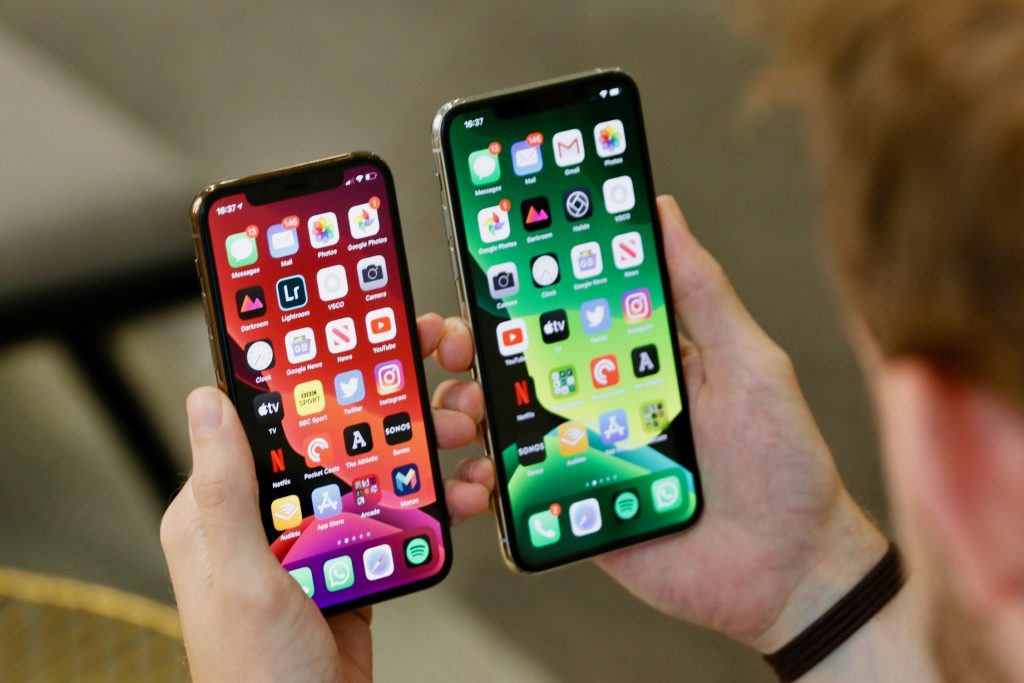
iPhone 11 Pro (left) 5.8-inches vs iPhone 11 Pro Max (right) 6.5-inches
One notable missing feature, that might really have truly earned that ‘Pro’ tag, is a faster refresh display. The ProMotion displays on the iPad Pro up the standard 60Hz to a maximum 120Hz, giving everything a much smoother look. It’s hard to explain just how much better a 90Hz or 120Hz screen is, but once you’ve seen it, it can be hard to go back. OnePlus introduced a 90Hz OLED with the OnePlus 7 Pro and it remains the finest screen on any smartphone.
Design
- More of the same
iPhone 11 Pro retains many of the design characteristics of the iPhone XS, and the iPhone X before it. Apple seems to have settled into a three-year update cycle for big design refreshes and that leaves the iPhone 11 Pro feeling very familiar – and a little stale.
It’s a good looking phone, don’t get me wrong, but we’ve seen it all before. The iPhone X was a huge shift in terms of looks for Apple phones and it felt fresh, now when you compare the 11 Pro to something like the OnePlus 7T Pro or Samsung Galaxy Note 10, and it doesn’t feel so fresh.
A lot of this comes from the notched display, which is a trait most Android phones have managed to shrink or get rid of entirely. The notch here remains the same size as it was two years ago and it does get in the way on this relatively small 5.8-inch screen.
If the front looks the same, the back has some differences. The Apple logo sits lower and there’s no branding elsewhere, which makes for a super-clean looking device. There’s also a lovely new matte finish on the back that rejects fingerprints and oily residue. This new finish is a little more slippery than the glossy, though, and that might mean you’ll perhaps need to add a case quicker than you originally wanted.
Of course, the elephant in the room with this year’s iPhone 11 Pro design is the rather ‘out there’ camera module. The three new sensors sit inside a glossy square, paired with a flash and microphone. In pictures, I admit, these look pretty ugly – big, bulbous and distracting. However, in reality I quite like it. The entire back is milled from a single piece of glass and the actual camera sensors don’t stick too far out. It’ll still wobble if you try and type with it on a table, though.
If you really hate the look then I would suggest plumping for the Space Grey or Midnight Green colours as the overall dark hue does a good job at covering up the cameras. With the Gold and Silver options, the contrasting black cameras stand out a lot more.
If you’re stuck between the 11 Pro and the 11 Pro Max, then size is one of the big differences. The 11 Pro is among the smaller flagship phones around and can just about be used comfortably with one hand. The regular 11 Pro is also much lighter and slightly thinner than the Max.
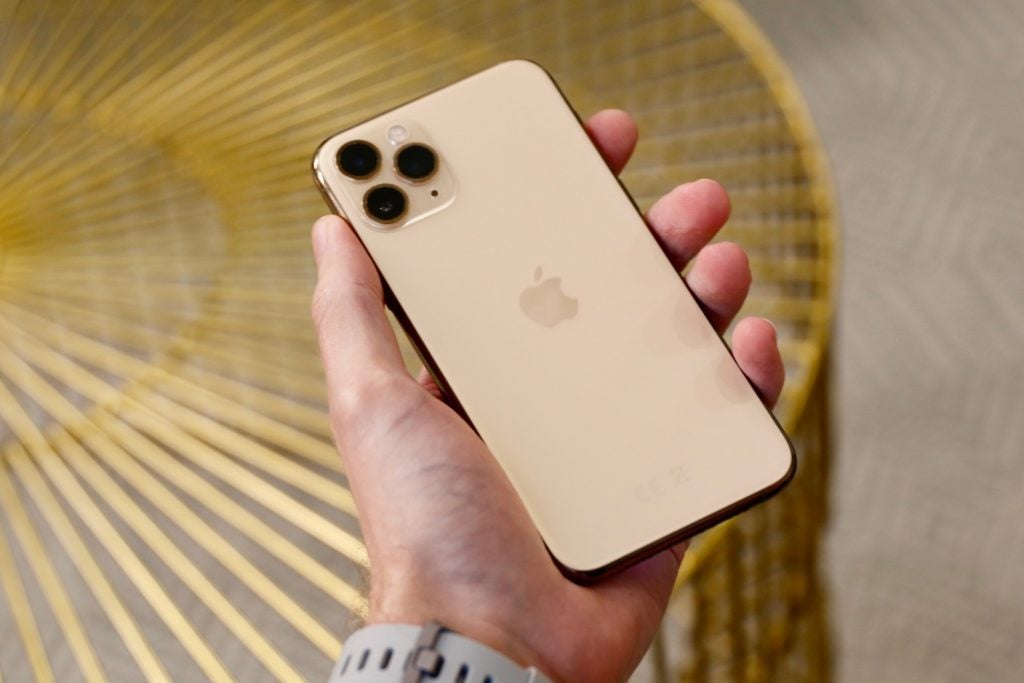
The camera array is certainly eye-catching
Apple says the glass used on these phones is the ‘toughest glass ever on a smartphone’ thanks to a ‘dual-ion exchange’. That may very well be true, but I am not going to purposely drop a £1000 smartphone onto concrete to test out those claims. What I have noticed is that the screen remains very easy to scratch – I had an obvious ding after only a few days of general use.
While the iPhone 11 Pro remains IP68 rated for water resistance, Apple now says the phone can be submerged in 4m of water for 30 minutes – up from 1m.
Battery Life
- Go for the iPhone 11 Pro Max if you want truly excellent endurance
The iPhone 11 Pro is the first time a 5.8-inch device from Apple hasn’t felt hamstrung by its battery life. With both the iPhone X and iPhone XS I felt the need to babysit the phones through the day (and maybe give them a top-up if I was going to have a long night), but with the iPhone 11 Pro that’s not the case.
Apple claims there has been a four hour improvement (that’s five hours with the Pro Max) when you compare the XS to the 11 Pro. That’s a hard metric to really replicate in real-world usage and, of course, battery varies wildly depending on how you use your phone. I would class my use as heavy, with plenty of picture-snapping and video recording throughout the day, and I still made it through the day without worrying. You can kill it quicker with heavy gaming or HDR video streaming, of course, so do always keep that in mind.
Apple has made the iPhone 11 Pro thicker and heavier to accommodate the larger battery and this is a great call. These phones don’t need to be thinner.
If you’re really wanting the best battery life possible then go for the Max. The iPhone 11 Pro Max is the best iPhone I have ever reviewed when it comes to endurance, easily making it through a day and a half with very heavy use.
Another big improvement to the battery here is a new 18w fast charger that comes bundled with the phone. While this isn’t anything new if you’re an Android die-hard, it’s a big boost for the iPhone, which has been saddled with a measly 5w charger since its first iteration. A full charge of the phone takes roughly (this seems to vary quite a lot) 95 minutes, however you’ll get about 40% in 30 minutes if you want a quick top up. Wireless Qi charging remains at the same 7.5w speeds as before.
Apple’s resistance to fully embracing USB-C is another big irritant I have with this phone. The idea of being able to charge the MacBook Pro, iPad Pro and iPhone 11 Pro with the same block and charger just makes so much sense. At least it now comes with a USB-C to Lightning cable.
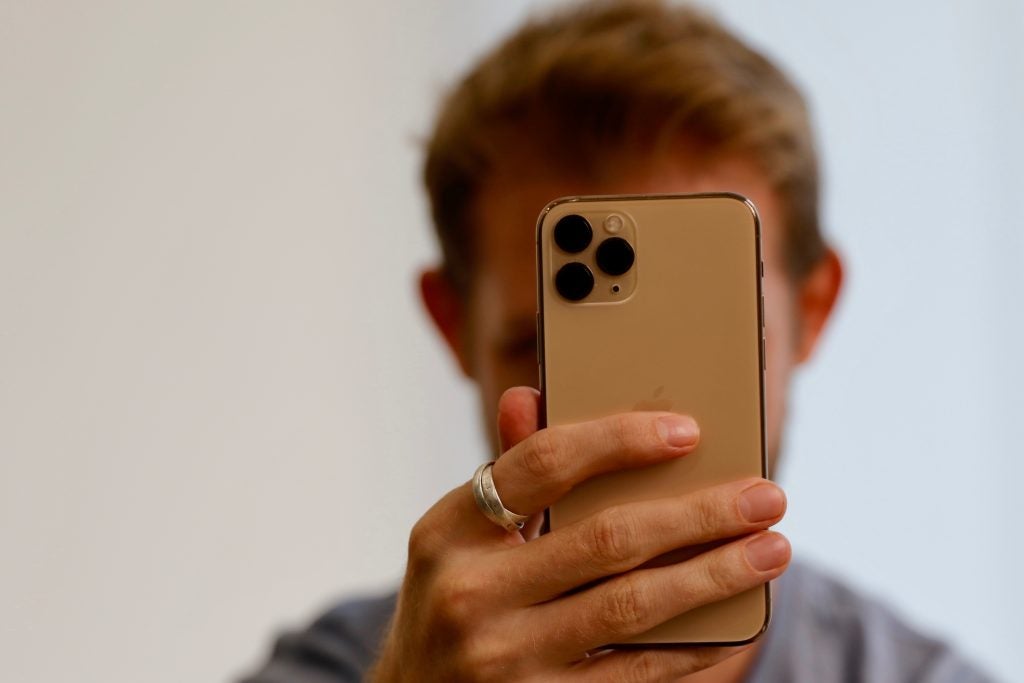
Should I buy the iPhone 11 Pro?
While the iPhone 11 Pro looks nearly identical to its predecessor, the changes Apple has made do make it a much better phone.
The three cameras on the back are truly excellent and might just about be my favourite trio of sensors on any phone. The video recording, audio and super-bright XDR display are all tremendous too. This is also the first 5.8-inch iPhone that doesn’t feel hamstrung by a battery that needs constant attention to get it through a full day.
All that being said there are still areas I would have liked to see Apple push forward in, especially as it has now decided to call these phones ‘Pro’. 5G was never going to happen, but would have been nice anyway; some sort of TouchID-enabled fingerprint sensor inside the display and the rumoured reverse wireless charging that could have juiced up a pair of AirPods would all have been welcome features.
Related: AirPods 3
And then we come to the design. While it’s still a looker, the iPhone 11 Pro lacks the futuristic all-screen looks of the OnePlus 7 Pro and Samsung Galaxy Note 10 Plus. The notch hasn’t been changed and it’s becoming more of a distraction as other phones find nifty ways to shrink it.
- These are the best iPhones you can buy
- Here are the best phones overall
- Not an iOS fan? Check out the best Android phones
But the biggest knock against the iPhone 11 Pro is the iPhone 11. Apple’s other new iPhone has the same main camera, the same ultra wide camera and the same A13 Bionic chipset inside. It’s also around £300/$300 cheaper and available in a much wider array of colours. The iPhone 11 Pro becomes a hard-sell when you consider just how good the iPhone 11 is.


